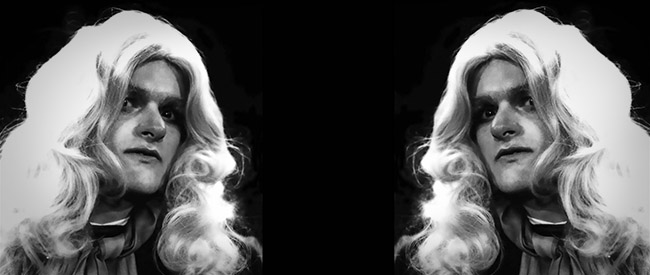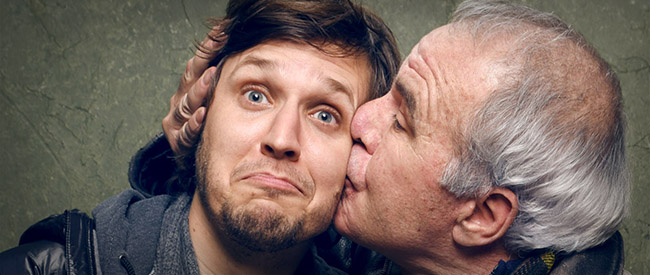Something Different Inside: Documentarian Brad Besser on ‘The Beaver Trilogy, Part IV’
Pop quiz: what do Sean Penn, Crispin Glover, Bill Hader and an Olivia Newton-John impersonator from rural Utah (nicknamed “Groovin’ Gary”) all have in common? The answer is both weird and complicated, but it all starts with cult Salt Lake City filmmaker Trent Harris and The Beaver Trilogy, his difficult-to-explain, meta-textual 2001 triptych of short films about big, big dreamers and small, small towns.
If you’re not immediately familiar with Trent’s name or filmography, don’t worry. For roughly three decades, Harris has mostly been a local Utah phenomenon whose work has touched the mainstream only rarely—and even then, only at odd angles.
For example: have you ever seen the YouTube clip of supposedly substance-addled Crispin Glover nearly karate-kicking David Letterman’s head off? Fun fact: during this infamous Late Night appearance, Glover was actually in character as “Rubin”—his role from Harris’s 1991 road-trip comedy, Rubin & Ed.
But Harris’s undisputed masterpiece is The Beaver Trilogy. A compilation of three short films made over several years, the movie (only available via direct purchase from Harris’s website) follows the same simple story, told three different ways.

The first, a short documentary shot but never aired for the 1980s Salt Lake City TV newsmagazine Extra, follows the story of “Groovin’ Gary”—a gregarious young man from small-town Beaver, who Harris discovers in the Extra parking lot taking photos of the show’s news helicopter. Gary cajoles Harris to Beaver for an impromptu talent show, where he takes to stage—in full drag—as his alter-ego “Olivia Newton-Dawn” to perform John’s melancholic 1978 hit, “Please Don’t Keep Me Waiting.”
The second chapter of The Beaver Trilogy—filmed as Harris’s AFI thesis several years later—is a fictionalized retelling of the same story starring an extremely young, pre-stardom Sean Penn as the cross-dressing lead.
The third and final part of the film is yet another retelling of the Groovin’ Gary story, this time with higher production values and a pre-Back to the Future Crispin Glover donning the blue eye shadow and blonde wig to belt out “Waiting.”

For years, Harris kept these films a secret before finally stringing them together and releasing them—to great acclaim—as a single feature in 2001. The film played at Sundance and was the subject of a popular This American Life segment.
But rather than basking in the accolades, Harris retreated from them. The reasons why are the subject of Brad Besser’s new documentary, The Beaver Trilogy, Part IV, which delves deeply into both The Beaver Trilogy, as well as Harris himself.
Besser’s documentary played at the 2014 Sundance Film Festival and is currently available on iTunes, Amazon and VOD. Besser spoke to Film Independent Digital Content Manager Matt Warren (a fellow Utah native). Here’s the transcript:
First of all, how do you describe what The Beaver Trilogy, Part 4 is to people? It seems complicated. You basically have to explain what The Beaver Trilogy is and who Trent Harris is first.
Yeah, the movie explains it so much better than I ever could. I’m taking the approach that it’s a movie with Sean Penn and Crispin Glover, narrated by Bill Hader. And that’s not even the interesting part. But the whole movie has been a secret. We were actually thinking of calling it The Secret Tapes of Trent Harris.
How’d the project get started?
So Trent shot these three short films: the documentary, the remake and then the remake of the remake. But he kept them a secret. I wanted to get to the bottom of that, so I go to Trent and about 10 minutes into the first interview he says he doesn’t want to talk about Beaver Trilogy. So then I followed Trent for about four years, off and on, and I can’t really tell him what I’m doing. Because if I told him I was making a movie about The Beaver Trilogy, I don’t think he would have gone along with it.
So he didn’t know why you were filming him?
No. I’d ask him 30 or 40 questions and sneak in a few Beaver Trilogy things here and there, and eventually I started to put a whole story together.
Has Trent seen the movie? What was his response?
He did! It was a fun experience, because I wanted to keep it a secret as long as I could. Eventually I made a film that I was comfortable with, and submitted it to Sundance. And then it got in so then I had to tell Trent that I’d just made the Beaver Trilogy documentary, which I was sure he was going to hate. So I go back to Salt Lake City and I have a little meeting with Trent. But instead of meeting at his office, he wants to meet at [local Salt Lake bar] Junior’s. After about three hours, he gets up to leave and I say, “Trent, I’ll walk you to your car”. He gives me a sideways look and while we’re walking to the car I tell him the movie got into Sundance. At that point he was pretty excited about it. I don’t think he saw any of it coming, but luckily for me [he’s] embraced the film. The Beaver Trilogy is just one part of this big career that Trent’s had, and to really understand the guy you have to understand where he’s coming from and the things going on in his mind.
How’d you get Bill Hader to be the film’s narrator?
Bill loves The Beaver Trilogy and was excited to do it for next to nothing, which was incredible. The guy’s so unbelievable. He just went in the booth and most of the time he’d nail it in the first take. Our producer Kelly Williams worked with him before, so Kelly reached out to him. We got him a copy of the movie and he liked it. Two weeks later we were recording the final narration.
What do you think young or aspiring filmmakers can learn from Trent’s career, either as a source of inspiration or as a cautionary tale?
That’s an interesting question. I think [Trent] learned a valuable lesson when he was in Hollywood. At one point he was kind of on the up-and-up. He was good friends with Sean Penn and Crispin Glover. He was getting deals to make movies like Rubin & Ed. But he still continued to struggle, and in that struggle I think he found that he was having more fun doing these smaller projects, and doing [them] his own way. And there’s something very noble about that, because you can get kind of lost when you get a couple of rejections. So maybe the story is that you don’t have to follow the path. I think that’s what my movie is trying to capture.
Why do you think the original Beaver Trilogy continues to resonate with people? Why has it become such a cult phenomenon?
Trent talks about the subtext. What was so interesting about that day in the parking lot, and the subsequent talent show in Beaver, was that the kid [“Groovin’” Gary] seemed to be saying something on the outside, but presenting something on the inside that was different. It’s amazing when you can capture something like that. There are so many ambiguities. You can take them in different directions, and there’s a group of people who just love those kinds of films. Bill Hader loved it. Paul Rudd loved it. We actually got James Franco into our screening, and little did I know James Franco was a Beaver Trilogy nut.
Why do you think Utah is so special in this weird way? Or is it special? Maybe it’s just that you and I find interesting because we’re from there.
Hmm. How to articulate this in a way that makes sense? I think that because there’s such religious and moral conflict in the city, the Mormon religion has bred this really strong counterculture. I saw it as the goths when I was in school, but even if it’s not people who are changing their appearance, they’re thinking very counter to what the Mormon religion is presenting, and there’s a nugget of that that manifests in art and filmmaking. That’s a hard question because it’s hard to define, but it is there.
The Beaver Trilogy, Part IV is currently available on iTunes, Amazon and VOD. Learn more about the film via the movie’s Twitter or Facebook page. To buy a copy of the original Beaver Trilogy on DVD, email Trent Harris at harristrent@yahoo.com.
To learn more about Film Independent, subscribe to our YouTube channel. You can catch up with the rest of our blog here. Learn how to become of Member of Film Independent, just click here.
(header: The Beaver Trilogy)
